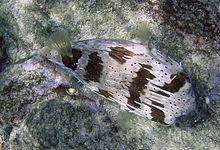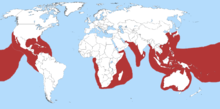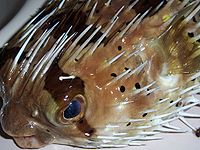- Long-spine porcupinefish
-
Long-spine porcupinefish 
Scientific classification Kingdom: Animalia Phylum: Chordata Class: Actinopterygii Order: Tetraodontiformes Family: Diodontidae Genus: Diodon Species: D. holocanthus Binomial name Diodon holocanthus
Linnaeus, 1758
Distribution of the Long-Spine Porcupinefish The long-spine porcupinefish is also known as the spiny balloonfish.
Contents
Range
The Long-spine porcupinefish is circumtropical in distribution, being found in the tropical zones of major seas and oceans:
- In the Atlantic it is found from Florida and the Bahamas to Brazil and in the Eastern Atlantic from 30°N to 23°S, as well as around South Africa.
- In the western Indian Ocean from the southern Red Sea to Madagascar, Réunion and Mauritius.
- In the Pacific Ocean from southern Japan to Lord Howe Island, and east to the Hawaiian and Easter islands. Also from southern California to Colombia and the Galapagos Islands.[1]
Description
Pale in colour with large black blotches and smaller black spots, these spots becoming fewer in number with age. Has many long, two-rooted depressible spines. Adults may reach 50 cm (20 in) in length.[2]
Diet
Feeds on mollusks (molluscs), sea urchins, hermit crabs, snails, and crabs during its active phase at night.[1]
Habitat
Found over the muddy sea bottom, or in lagoons or seaward and reefs around the world.
Spawning
Spawns at the surface at dawn or at dusk in pairs or in groups of males with a single female; the juveniles remain pelagic until they are at least 7 cm (3 in) long.[2] Young and sub-adult fish sometimes occur in groups.
Uses
It is used in Chinese medicine, and is captured at the surface with a hand net. It is poisonous if not prepared correctly.
References
- ^ a b Froese, Rainer, and Daniel Pauly, eds. (2007). "diodon holocanthus" in FishBase. 6 2007 version.
- ^ a b Lieske, E. and Myers, R.F. (2004) Coral reef guide; Red Sea London, HarperCollins ISBN 0-00-715986-2
Categories:- Diodontidae
- Fish of the Red Sea
- Fish of the Indian Ocean
- Fish of Hawaii
- Animals described in 1758
Wikimedia Foundation. 2010.


